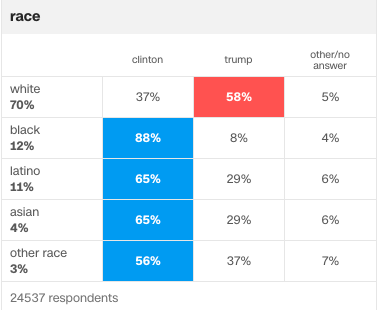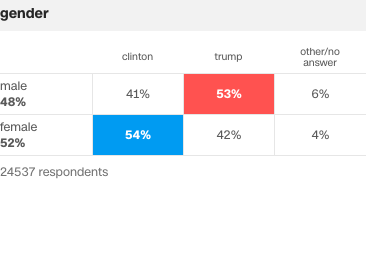Exit polling in the US Presidential Election shows it was “racism and misogyny” that won Donald Trump the election rather than a “working class” revolt, journalist Paul Mason has said.
Commentators and pollsters have scrambled to try and understand why they failed to anticipate a Trump victory over Hillary Clinton - something HuffPost polling in America said less than a 2% chance of happening.
CNN exit polls that showed Clinton was favoured by Americans who earn less than $50,000 a year, while Trump was backed by those who earned more.
The broadcaster’s polling also showed race was a key factor in how people voted.
The broadcaster’s polling also showed race and gender were key factors in how people voted.


Canada’s The Globe & Mail columnist Doug Sanders supported this view, writing that Trump supporters were “white, well-off and segregated”.
“It was described, over and over, as a movement made up of blue-collar victims of a faltering economy whose lives have been changed by trade and immigration,” he said.
“But when it came to the crunch, it turned out that Donald Trump’s backers were something else entirely.
“Both far more numerous and much less economically marginal than believed.”
He wrote that Trump’s average voter was more likely to be white, old and well off rather than “the poverty-stricken victims of globalisation portrayed by the Trump campaign”.
Mason also tweeted The New York Times’ exit polling, saying it showed racism and misogyny were the two driving factors.
But he was challenged on this by Resolution Foundation Director Torsten Bell, who said the poorest voters were those most likely to have swung to the Republican.
In a series of tweets, Bell argued that a decline in the number of Americans working and the failure of wages to rise with the growth of the economy.
On Wednesday, HuffPost’s US editon published a post-mortem on how polls could have been so wrong.
“Unlike in Britain’s Brexit referendum, where even “shy” voters were willing to admit their preferences in online surveys, Trump’s support seems to have passed entirely under the radar,” polling directors Natalie Jackson and Ariel Edwards-Levy wrote.
“Claims that there was a “silent majority” or “shy Trump” voters can’t be ignored. If those are indeed where the polls missed, it’s time to take a good, hard look at surveys’ extremely low response rates, as well as how we locate voters.”
